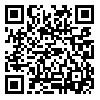Volume 24, Issue 5 (2022)
JAST 2022, 24(5): 1117-1128 |
Back to browse issues page
Download citation:
BibTeX | RIS | EndNote | Medlars | ProCite | Reference Manager | RefWorks
Send citation to:



BibTeX | RIS | EndNote | Medlars | ProCite | Reference Manager | RefWorks
Send citation to:
Taghikhani N, Sahragard A, Fathipour Y, Madahi K. Successive rearing on Sitotroga cerealella Affects Quality of the Parasitoid Wasp Trichogramma embryophagum (Hymenoptera: Trichogrammatidae). JAST 2022; 24 (5) :1117-1128
URL: http://jast.modares.ac.ir/article-23-53493-en.html
URL: http://jast.modares.ac.ir/article-23-53493-en.html
1- Department of Plant Protection, Faculty of Agricultural Sciences, University of Guilan, Rasht, Islamic Republic of Iran.
2- Department of Entomology, Faculty of Agriculture, Tarbiat Modares University, Tehran, Islamic Republic of Iran. ,fathi@modares.ac.ir
2- Department of Entomology, Faculty of Agriculture, Tarbiat Modares University, Tehran, Islamic Republic of Iran. ,
Abstract: (1992 Views)
Demographic parameters of the parasitoid wasp Trichogramma embryophagum Hartig reared on Sitotroga cerealella (Olivier) were determined for 40 generations (G5-G40). The experiments were done in a growth chamber at 26±2°C, 65±5% RH and photoperiod of 16:8 h (L:D). The results showed that the female longevity decreased significantly during successive production, ranging from 10.68 (in G5) to 9.64 days (in G40). On the other hand, the male longevity decreased significantly in the 20th generation and no significant difference was found from G20 to G40. The oviposition days and mean total fecundity of T. embryophagum decreased as the number of generations increased. Generally, the wasps in earlier generations had longer adult longevity, longer life span, and higher fecundity than later generations. Moreover, sex ratio of T. embryophagum was not significantly different in successive generations. Results of paired bootstrap test indicated that all population growth parameters of T. embryophagum reared on S. cereallela were significantly different in successive generations. The highest and lowest values of the intrinsic rate of increase (r), finite rate of increase (λ), net Reproductive rate (R0), Gross Reproductive Rate (GRR) and mean generation Time (T) of T. embryophagum were observed in G40 and G5, respectively. These results suggest that T. embryophagum wasps reared in sequential generations can be used successfully in biological control programs until the 20th generation without any loss of quality or performance; after that, regular rejuvenation of laboratory population by occasional importing of field-collected parasitoids should be done.
Keywords: Different generations, Life table, Population growth parameters, Quality control, Rejuvenating population, Trichogramma.
Article Type: Original Research |
Subject:
Plant Protection/Biological control
Received: 2021/06/22 | Accepted: 2021/08/23 | Published: 2022/09/14
Received: 2021/06/22 | Accepted: 2021/08/23 | Published: 2022/09/14
Send email to the article author
| Rights and permissions | |
 |
This work is licensed under a Creative Commons Attribution-NonCommercial 4.0 International License. |







